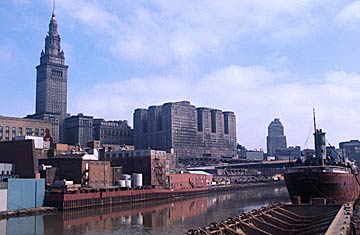
March 11, 1970: Views of the Cuyahoga River shown here, the river is a constant fire hazard because of quantities of oil deposited in it by numerous industries in the Cleveland area.
(2 of 2)
Erie's littoral U.S. cities. Washington has asked industry to spend another $285 million on waste-treatment equipment. But schedules are being met by only 15 of the 102 target cities and 32 of the 100 major industrial polluters. The trouble is that pollution rarely gets a high priority until profits are affected or people are killed.
Cleveland, however, shook off its apathy last year. Much of the credit goes to Ben Stefanski, a 30-year-old lawyer-turned-urbanist, whom Mayor Stokes had just appointed to be Cleveland's director of public utilities. Making up in enthusiasm what he lacked in experience, Stefanski persuaded Stokes to start a massive effort to scrub the Cuyahoga, and hence aid Lake Erie. The proposed price tag: $100 million in bonds, to improve existing facilities and build 25 miles of trunk-line sewers plus a modern sewage treatment plant.
Like Apple Pie. "We have some of the lowest sewer tax rates in the country," says Stefanski. "I figured we'd double the rates to amortize our bonds." To persuade the people to pay, Stefanski enlisted newspaper support, lined up citizen groups and got 33 suburban governments to endorse the plan. "It became like apple pie and motherhood," he recalls. "No one could be against clean water." Last fall Clevelanders approved the bond issue by a vote of 2 to 1, giving it more "yes" votes than any other proposal on the ballot. In five years, Cleveland should have the best sewage system in the U.S., one capable of handling even industrial wastes.
The accomplishment, huge as it is, only fixes the price of optimism. Unfortunately, water pollution knows no political boundaries. The Cuyahoga can be cleaned up in Cleveland, but as long as other cities keep dumping wastes upriver, it will remain exactly what it is today—an open sewer filling Lake Erie with scummy wavelets, sullen reminders that even a great lake can die.
